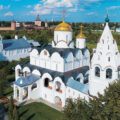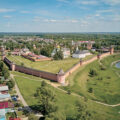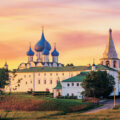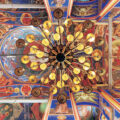Suzdal is a real jewelry of the Golden Ring of Russia. This year, the city celebrates its 1,000th anniversary of the first written mention of the city.
A miracle happened to ancient Suzdal. In the years when atheism was planted in the country and churches were destroyed, most of the old architecture was preserved in a small town in the Vladimir Region, with less than 10,000 inhabitants. And today, there are over 50 temples, cathedrals, and monasteries there. Among them, three are included in the UNESCO World Heritage Site “The White Monuments of Vladimir and Suzdal”: the Suzdal Kremlin, the Monastery of Saint Euthymius, and the Church of Boris and Gleb in the village of Kideksha near Suzdal.
Nigh-hand
It is only 190 kilometers from Moscow to Suzdal in a straight line. Once in this wonderful city, you will find yourself in another time: the walls of ancient monasteries, domes of churches and ancient wooden houses on its streets replace each other. Everything in Suzdal breathes antiquity. Just as hundreds of years ago, clouds fly over the domes of the Cathedral of the Nativity, horse-drawn carriages roll along the streets, and the cobblestone roads keep the memory of thousands of those who once stepped on this land.
But at the same time, Suzdal, which lives largely due to tourism, is very sensitive to modern trends in the rules of reception and service of guests. There is a large number of various hotels, catering and leisure facilities here, and tourist infrastructure is well developed. The concept of “hospitality culture” for local residents is filled with a very specific content.
Monastic Grace
The objects of the Vladimir and Suzdal Museum — the Suzdal Kremlin, a large-scale complex of white stone monuments of the 12th–13th centuries, the ensemble of the Monastery of Saint Euthymius, the Museum of Wooden Architecture, and the Church of Boris and Gleb in Kideksha — are among the must-visit attractions of Suzdal in any guidebooks.
The Monastery of Saint Euthymius was founded in 1352 and by the end of the 17th century had become one of the richest in Russia. The existing stone ensemble of the monastery was formed in the 16th–17th centuries. Generous donations for its construction and maintenance were made by Tsars Vasily III, Ivan the Terrible, and Princes Pozharsky. The heir to the throne, the future Emperor Alexander II, as well as Emperor Nicholas II visited this monastery.
To the left of the cathedral, there is the Assumption Church built in 1525.
In the territory of the monastery, there are the Church of the Annunciation and St. Nicholas Hospital with wards for the monastic brotherhood. In 2023, by order of the museum, scientific and design documentation was developed for the restoration of the Prison Ward of the 19th century.
In addition, the resting place of the national hero of Russia Prince Dmitry Pozharsky is located here. He was buried in the family tomb in 1642. In 1885, a chapel monument was built over his grave with public funds, it was destroyed in Soviet times and then restored in 2009. A cross and a memorial plaque appeared at the burial site of the commander.
It would seem that in the ancient monastery everything is at peace. But it’s far from that! The Vladimir and Suzdal Museum revives the gardens of the monastery lost in the 20th century. In the summer of 2023, the first stage of landscaping started, the Large and Small Abbot Gardens were decorated, work was carried out at the entrance group, and the transformation of the Pharmacy Garden was completed.
“Reviving the gardens and restoring the historical appearance of the monastery will make this place even more attractive to the tourists,” said Ekaterina Pronicheva, general director of the Vladimir and Suzdal Museum. “The gardens and the Pharmacy Garden will become another important open-air exposition.”
- Богородице-Рождественский собор / Cathedral of the Nativity
- Внутреннее убранство Богородице-Рождественского собора / Interior of the Cathedral of the Nativity
The Ancient Kremlin
The Suzdal Kremlin is the core of the medieval city, its oldest fortified part. The ramparts around it were built in the 10th–11th centuries and survived to the present day. Since 1992, the Kremlin has been part of a complex object from the UNESCO World Heritage List White Monuments of Vladimir and Suzdal. In November 2023, the restoration of the “Bell Tower with a house church” of the 17th century was successfully completed.
The dominant feature of this part of Suzdal is the Cathedral of the Nativity, a wonderful monument of white stone architecture of Vladimir–Suzdal Rus of the pre-Mongol period. Its construction started at the beginning of the 13th century. The facades of the walls and portals of the temple were richly decorated with carvings on white stone. Over time, the cathedral was rebuilt several times. Now, it needs restoration. In 2020, by order of the museum, scientific and design documentation for these works was developed, it was approved by the Ministry of Culture of the Russian Federation.
This is of paramount importance since Suzdal receives more and more tourists every year, and the Kremlin is their main point of attraction. In the Cathedral of the Nativity, visitors can get acquainted with the monuments of ancient Russian painting of the 13th–17th centuries as well as with the Golden Gates of the 13th century made in the technique of fire gilding.
The iconostasis of the temple was created between 1683 and 1696. Several icons were painted by Georgy Zinoviev, the royal icon-painter, a student of Simon Ushakov. The cathedral’s furniture is noteworthy: the copper chandelier of the 16th century, a huge portable lantern of the 17th century, a holy water bowl of the 19th century made in the form of a samovar, with four taps for distributing holy water to parishioners.
On June 12, 2024, on the Day of Russia, the largest and most ceremonial room of the Kremlin — the Cross Chamber — hosted a unique exhibition Russian Phoenix. Suzdal Land prepared jointly with the Moscow Kremlin Museums. This is the most important event of the celebration of the 1,000th anniversary of the first written mention of Suzdal.
The Vladimir Craftsmen
The Museum of Wooden Architecture is as attractive for tourists as the famous Suzdal temples and monasteries. It’s almost always crowded here. Last year, for example, it was visited by almost 200,000 people.
In the territory of the museum, there are 19 unique buildings and structures made of wood that were transported from different parts of the Vladimir Region. The visitors can see the image of a Russian village: with temples, courtyards, household, and public buildings. All of them convey the beauty of Russian wooden architecture, the art of Vladimir craftsmen.
Right on the spot of the present Museum of Wooden Architecture, there used be first the Dmitrievo-Pechersky Monastery founded in the 11th century and active in the Russian Middle Ages and then two parish churches lost in the 1930s. When the site was transferred to the museum, there were still the foundations of these stone temples; and behind them, the former urban garden lands, now Dmitrovskiy meadow. So the wooden temples transferred to the museum — Voskresenskiy and Preobrazhenskiy — revived the historical urban silhouette to be the high-rise dominant of this part of Suzdal.
New Horizons
In the year of the 1,000th anniversary of Ancient Suzdal, hundreds of thousands of guests will visit this town. Local authorities are improving urban infrastructure, putting roads and buildings in order, and forming a largescale cultural program.
The museum is also a part of this program. New exhibitions and events, new ideas and plans are in progress: at the beginning of the year, Vladimir hosted the Mstera Multifaceted exhibition; in March, the exposition of the Bogolubovo Icon of the Mother of God of the 12th century opened, with its restoration lasting about a hundred years. And, of course, work will continue in the Monastery of Saint Euthymius. Gradually, the gardens will surround all the walls of the ancient monastery.
Mikhail Mayorov
Photo: The Vladimir and Suzdal Museum




